How to choose an oil heater: tips for buyers and a review of the best options
It doesn’t matter whether you live in an apartment or in your own country house, heating problems can arise anywhere and, as a rule, at the most inopportune moment. And they will have to be resolved urgently. If you don’t want this problem to take you by surprise, you should take care in advance of purchasing a reliable heat source.
From the article we presented you will learn how to choose an oil heater. For future owners of the device, we have provided all the criteria that influence the determination of the best model for you. Taking our recommendations into account will eliminate and prevent all possible errors.
The content of the article:
How does an oil heater work?
The radiator, as you might guess, is the most important part of any oil heater. It is made of ferrous metal. The thickness of the radiator walls is 0.8-1 mm. All components of this product must have precise dimensions, so laser cutting of metal is used when cutting.
This technology allows you to make the edges of parts even and smooth. Small radiator elements are made by stamping, and sheet bending equipment is used to make right angles.
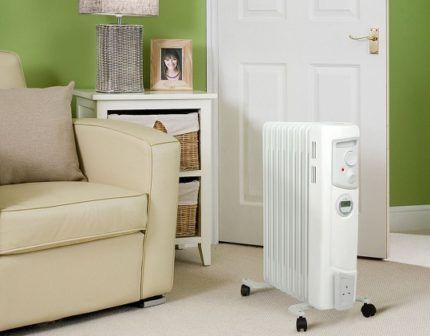
Since we are talking about a heating device into which oil will be poured, its sections must be absolutely sealed. This parameter is achieved by the method of spot microwelding of individual parts with each other, followed by pressing.
So that the sections can be connected to each other, special holes are provided in their design. The radiator is assembled using a reliable nipple connection that does not allow leaks.
A durable coating is applied to the finished radiator using powder technology, in which the paint polymerizes as a result of heating in a special oven.
Mineral transformer oil is a filler poured into the assembled heater radiator. Once upon a time, the first oil heaters were filled with oil through a special valve. Now, filling the containers is done during the assembly of the device.
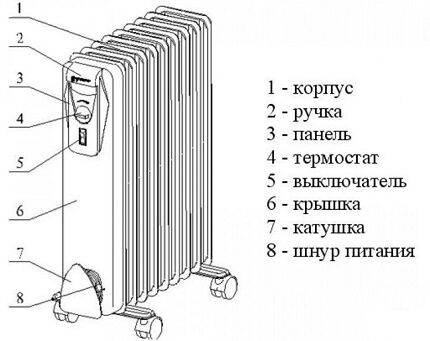
Without breaking the tightness of the device, an electric heater is inserted into it, after which overhead side panels made of metal and plastic are fixed on the outside. The front panel contains a thermostat, overheating protection and a power regulator. All that remains is to connect a cable with a plug to the finished device, which will ensure its power supply.
When a specific place in the room has already been determined for the heater, you need to secure the wheels with a bracket in the lower part of its body.This is done using special fasteners with nuts included in the device package.
He will familiarize himself with the positive and negative sides of electric radiators of all types, including oil-based devices. next article, which we recommend reading.
Operating principle of oil heating device
First of all, we turn on the heater to the network, and then use the thermostat to set the air temperature to a level that will ensure a comfortable environment in your room. What happens to the device itself?
The heating process consists of several stages and looks like this:
- First, the heating element (electric heater) heats up;
- from the heating element, thermal energy is transferred to mineral oil - the coolant;
- the oil warms up the radiator housing;
- the body of the device, like a conventional radiator, warms the air in the room.
In fact, the heating of the room is carried out by convection. It is believed that the maximum temperature that can be reached by heating the radiator housing of the device is 150 degrees. Not all models are capable of heating up like this; more often the heating threshold is still lower. But the case temperature will not rise above the specified maximum.
Budget models without a built-in temperature control system are recommended to be equipped with thermostats in the socket. You will learn how to choose and use them from our recommended article.
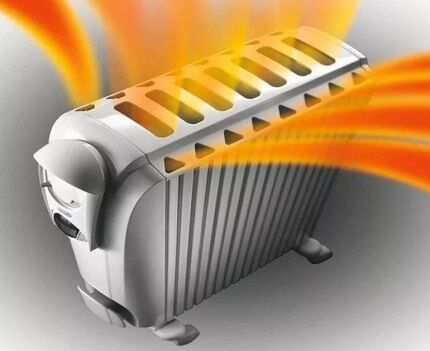
In order for the air in the room to warm up faster, you need to speed up the process of mixing the cold mass with the heated currents. It is for this reason that a number of manufacturers supply their models with fans. Such an oil heater will warm up the room much faster.
If your model does not come with a fan, you can use your own, with which you fought the heat in the summer. The effect will be the same. The good thing about a stand-alone fan is that it can be oriented towards the area of the room where we primarily need heat.
Additional Features Worth Considering
Advanced models of oil heaters have additional functions that improve the performance of the device, while at the same time slightly increasing its cost.
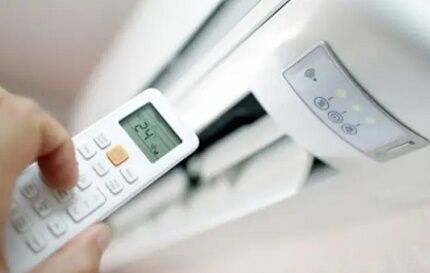
Here are examples of additional functions demanded by customers:
No. 1. Air humidification. When using heating devices, the air in the room often becomes dry, and additional moisture would be very useful. A number of electric oil heaters are equipped with a simple device that helps humidify the air.
Usually this is a container into which the owners themselves must pour water. When the device heats up, the water from the container evaporates, thus compensating for the lack of moisture. If this useful function is not provided in the model, it is advisable to purchase humidifierto maintain the level of moisture necessary for breathing.
The purchase will significantly increase the level of comfort humidifier-air purifier. In addition to increasing humidity, this device will also get rid of dust suspended in the air - a traditional companion of convective heating.
No. 2. Increased security. If it is cold in a house or apartment, then we strive to increase the air temperature primarily in those rooms where children sleep or play.
A hot radiator is a potential danger for children, so it is better to cover it with a protective cover. It should be taken into account that the casing also has disadvantages: it complicates the convection process. However, the safety of the child is worth it.
No. 3. Programming and remote control. If a remote control is included with the heater, the device can be controlled from a distance. If the radiator has a built-in timer that turns the device on and off depending on the degree of its heating, then your room will be warm and cozy without unnecessary costs for electricity.
You can program the device to turn on half an hour before you wake up, so that the air temperature in the house when you wake up is as comfortable as possible.
No. 4. Ease of movement. As a rule, rollers are included in the basic package of an oil heater. Whether to use them or not is the decision of the owner of the device, because it is he who will screw this device to the bottom of the device.
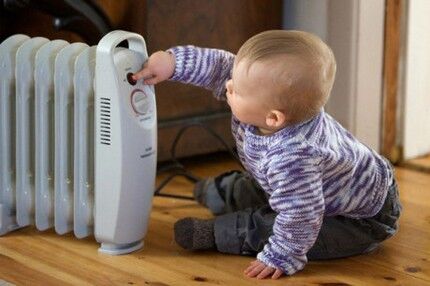
The list of additional elements that radiator manufacturers equip their devices with is not complete. This could be a clothes dryer, overheating and tip-over protection mechanisms, etc. In any case, it is the buyer who makes the final choice of those functions for which he would like to give his money.
Main selection criteria
Choosing the best heater - a rather complex task, the solution of which largely depends on the goals that the buyer has set for himself. But there are key criteria that I would like to draw your attention to:
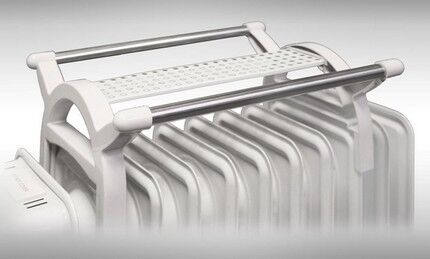
No. 1. Technical parameters. The main attention should be paid to the power of the device. This characteristic will be discussed further below. Here it is enough to mention that the power must be interconnected with the size of the room that needs heating.
We need a radiator to create comfort in the house, so preference should be given to a more powerful model.After all, it’s very disappointing when, after purchasing a low-power model, you continue to freeze. A fairly powerful product that has at least 2 heating modes, a temperature controller and a built-in thermostat deserves attention.
No. 2. Section sizes. Geometrically, the parameters of the device also matter. Narrow sections heat up faster, using less electricity for this process, but their total surface area is small. Therefore, heating the air in the room with their help will not happen too quickly.
Wide sections can be quickly cooled by air, so more electricity will be needed to heat them up. By choosing the parameters of the sections, you are essentially making a choice between the speed of heating the room and savings.
No. 3. Weight. Do not buy a device that is too light and has impressive dimensions. This effect can occur if the metal used to make the radiator is too thin or for some reason there is not enough oil in the device.
No. 4. Additional elements. In the off-season, when it’s already cold outside and it’s raining, and you haven’t even thought about turning on the heating, you need to somehow solve the problem of drying clothes. It cannot be placed directly on the heater, as on a regular radiator. But buying a device directly with a dryer is an excellent way out. It is better to ignore unnecessary options.
No. 5. Appearance. Any device must not only perform its assigned functions, but also be pleasing to the eye. If a designer has worked hard on the interior of your country house, it would be a shame to ruin all his efforts by purchasing an item that is discordant with the surrounding space.
Moreover, there is plenty to choose from: stores present to our attention models from different manufacturers, colors, shapes and sizes.There are also neutral products that can fit into almost any interior.
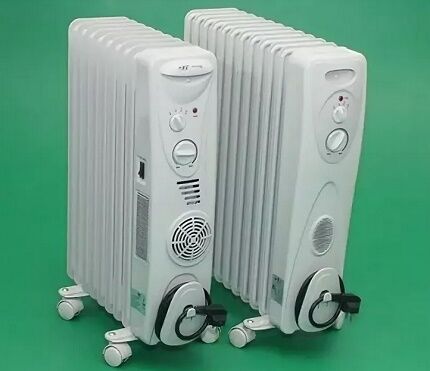
An oil heater is a device that should serve you for many years. When purchasing it, do not forget to correctly fill out all the documents that will allow you to apply for warranty repairs if such a need arises.
Calculation of device power requirements
If we do not want to overpay for the excess power of the device, we must know our own actual need for this radiator parameter. This characteristic directly depends on the volume of the room that needs to be heated.
There is a rule that should be used when calculating the power of the heating device any type. It is as follows: to heat every ten square meters of a room you will need only 1 kW of energy emitted by your radiator.
Although we called this condition universal, it should be mentioned that we are talking about apartments whose ceilings have a standard height of 2.75 meters. How to calculate the power requirement of the device if the ceilings in your apartment are located at a different distance from the floor?
We offer you the following algorithm that can be used in this case:
- multiply the length of the room by its width, calculating the area of the room;
- multiply the resulting result by the actual height of the room, determining the volume of the room;
- Let's divide the calculated volume by 25, obtaining a value corresponding to the number of kW that will be required to heat our room.
The division is made precisely by 25, since it is believed that for heating 25 m3 1 kW of energy will be required.
To summarize the calculations and reasoning, let's say that for a standard room, the area of which is close to 20 square meters. meters, a 1.5 kW radiator will be quite enough. If the room is larger, you need to choose a more powerful model.
In modern stores, oil heaters, the power of which does not exceed 2.5 kW, are presented widely enough so that you can choose the device that best suits you.
Features of operation and care
Oil heaters do not require extensive complex care or special maintenance. To clean the surface of the device, simply wipe it with a soft, dry cloth.
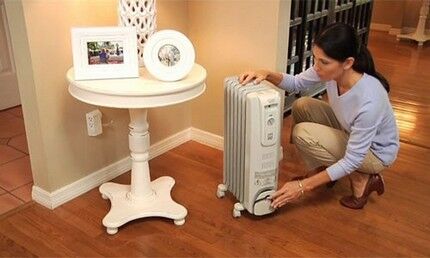
Abrasive agents cannot be used to clean it.
When using this type of heating device, some precautions should be taken:
- It should not be used in rooms where the humidity is high, unless the devices are equipped with special protection, information about which is included in the product passport.
- The power cord should not come into contact with the radiator body, as high temperatures can melt the insulation of the wire, and this is dangerous!
- The heater can only be operated when it is positioned strictly vertically; it must not be turned over!
- The heater must not be placed close to electrical equipment or a power outlet!
- When connecting equipment to the network, you should not use an extension cord, since during operation it may overheat and catch fire.
- The device must not be installed near furniture, textiles or other flammable or fusible materials.
- The radiator should be carried by holding it by the special handle: pulling it by the cord is prohibited!
- An oil heater cannot be stored on a balcony, in a garage or in a shed, because under such storage conditions it will fail early.
- Do not use the device in rooms designated for storing explosive materials!
- An oil heater can only be used for the period specified in the manufacturer’s passport.
- If the device is leaking, then do not rush to send it in for repair: it is better to buy a new one, because fresh coolant will no longer be pumped into the container, and due to the leak, its quantity now does not correspond to the stated technical parameters.
I would like to once again draw your attention to the dangers of improper operation of this electrical appliance. If you turn on an oil heater in the “lying” position, its hot oil can rupture the housing and cause a fire. After all, mineral oil does not fill the container to the top.
When the device is on its side, the heating element is partially exposed, which means it is in contact with an oxygen-aggressive environment. The operating temperature of the heating device will then increase and the coolant will begin to burn out.
Soot will appear on the walls inside, preventing normal heat transfer. The device will have to work with increased load, which is why it will fail much earlier than the manufacturer promised.
It is also undesirable for the heater to operate when its overheating sensor is faulty.In this case, heating will not be interrupted when the maximum critical temperature is reached. The device will not turn off, but will heat up until it burns out.
The worst forecasts promise a fire that will develop into a fire if no one stops it in a timely manner. A fire hazard can be created by items hung to dry on an oil radiator.
The heater can easily overheat and cause a fire. The same consequences will be caused by foreign objects in the outlet and ventilation openings. If you listen to our advice, then buy a high-quality and reliable device that will serve you for many years, always helping you out when the need arises.
Review of the best models
Many domestic and foreign companies are engaged in the production of oil heaters. The most popular products are from DeLonghi (Italy), Bimtek (Germany) and General Climate (Holland). This fact does not mean that the products of other manufacturers are bad.
The companies listed simply are the best on the world market today. Tomorrow the situation may change.
If we talk about the domestic market, we invite you to familiarize yourself with the best models of oil radiators presented in different price categories.
Selection criteria for comparison
To compare heating devices with each other, we chose the following characteristics:
- power;
- safety and reliability in operation;
- body parameters;
- presence of additional functions.
We have already talked about power and additional functions above and will not repeat ourselves. Let's talk about the reliability and safety of products.

The domestic market is filled with products made in China. There are, of course, models made together. In addition, Chinese production is most often carried out on the basis of licenses granted by European companies. However, these facts do not in any way affect the quality of what is on our shelves.
Therefore, we will exclude the argument in the form of the name of the manufacturer from the concept of “reliability”, and will focus our attention on functions that can increase the safety of using the product in a home or apartment.
As for the parameters of the model’s body, this indicator is of great importance. After all, the temperature of its heating depends on the size of the device. If you compare two radiators with the same power, make sure that the smaller one heats up first.
But once heated, a larger surface area remains hot longer.Therefore, the buyer himself will have to evaluate this parameter based on the goals he planned to achieve.
The best inexpensive models
The models were selected based on customer reviews from among inexpensive models, the price of which is in the range of 2300 - 2600 rubles.
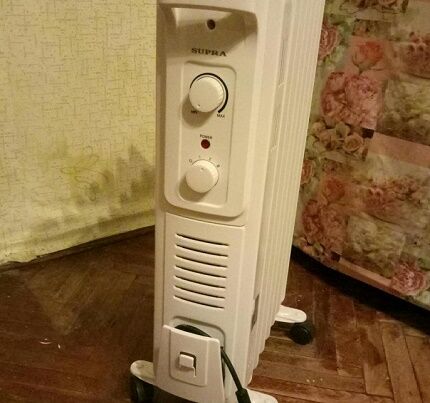
The list of leaders in terms of demand is headed by:
- SUPRA ORS-07-SN. This is a small device that does its job well and is not burdened with any unnecessary functions. However, it has everything you need: a regulator, a power indicator light, wheels and a cord compartment. SUPRA ORS-07-SN is protected from overheating. This model has no significant disadvantages.
- Hyundai H-HO1-05-UI550. This model is designed to work in a room whose size does not exceed 14 m2. It can act as additional heating or can be used for local heating, located, for example, next to the owner’s workplace. The advantage of the Hyundai H-HO1-05-UI550 is its low weight (5 kg), as well as the presence of protection against overheating and frost.
- Timberk TOR 21.1005 SLX. The device has a power of 1.8 kW, but, based on the passport data, is capable of heating a room measuring 24 m2. The heater is equipped with electronic control and has a fireplace effect. The disadvantages include the strong heating of the case, the surface of which can even get burned.
With proper use, models proven in practice will last as long as the manufacturers promised.
Average price category
If you are ready to spend a little more money on organizing a comfortable environment in your home, you can consider several models from the middle price category, in which the cost varies from 3,400 to 3,500 rubles.
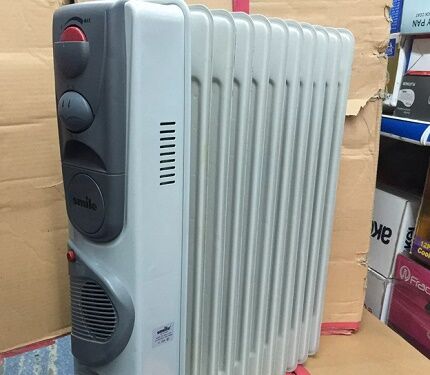
List of the most popular representatives of the mid-price segment:
- Resanta-OM-7NV. This model will delight aesthetes with its attractive appearance: the gray-blue body of the device is equipped with bright elements. With a power of 1.9 kW, it quickly heats the room thanks to the built-in fan. The advantages include the reliability of this product.
- Polaris PRE M 0920. When you turn it on for the first time, you may notice a slight plastic odor, which will disappear as you continue to use the heater. The device has three operating modes, and it heats so well that you will only need maximum heating when frost sets in or when the heating is completely turned off.
- General Climate NY23LA. Let's say right away that there is no timer in the design of the device. This is his only drawback. Now let's move on to the advantages. This product with a durable body is equipped with two heating elements.
The outermost heater described can be used to operate in conditions of initial sub-zero temperatures, due to the presence of a frost protection function in it. If you run it in automatic mode, it will maintain a room temperature of +5ºС.
Expensive devices with additional functions
If your finances allow you to buy whatever you want, you can purchase one of the expensive miracle devices (price from 3,700 rubles and above), which, in addition to heating, will delight you with its additional capabilities.
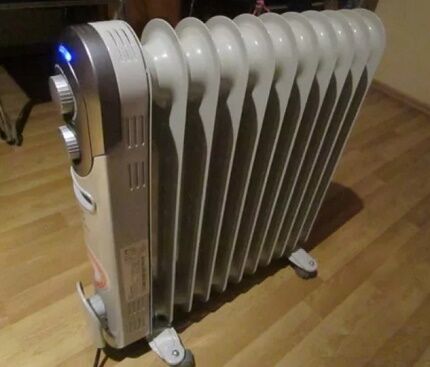
The ranks of elite equipment are headed by:
- Electrolux EOH/M-4209. This device will quickly heat up your room thanks to the fireplace effect. This is the name for increased traction, which is created thanks to special slots located in the radiator housing. The heater is equipped with a compartment for the cord, does not emit odors, and turns off when overheated.
- Rolsen ROH-D9. This model has only seven sections, but with the help of a built-in fan it will quickly heat a room up to 20 m2. It is advisable to use it for additional heating of premises in apartment buildings.
- Electrolux EOH/M-1221. Although this model does not have a timer, its advantages are great: it can be safely used in rooms with high humidity. If you buy this device, you will never have to take a bath in a cold room.
Let's take a closer look at the third model. If the radiator is accidentally knocked over, the device will immediately turn off.
It is protected from overheating, has a fireplace effect and is equipped with wheels that can rotate in different directions.
Conclusions and useful video on the topic
In this video, buyers' attention is drawn to those purchase parameters that we did not consider in this article in order to avoid duplication of information. It will help you avoid mistakes and get what you need.
It doesn't matter whether you buy one of our recommended oil heater models or choose something else. If you have read this article, then you know how to choose and what criteria you should follow to understand which oil heater is best for you. So, guided by these criteria and common sense, you will make the right choice.
Tell us about how you selected an oil heater for your cottage/office/apartment. Share what was the decisive factor when making a purchase. Please write comments in the block below, post photos related to the topic of the article, and ask questions about points of interest.




We have a two-room country house - a dacha, where we go on weekends. Heating is always a problem. We used a fan heater before, but not everything was satisfactory. It made a very loud noise, like a vacuum cleaner. And the air was dry, sometimes it smelled burnt. They were afraid to leave him unattended. Now we have purchased an oil cooler, not Chinese, expensive. It has one drawback: it takes a long time to warm up, but then it warms up the room well. Now we have adjusted, immediately upon arrival we turn it on and go to the yard or garden to work. And when we enter the house, it’s already warm there. It’s good that it’s on wheels, so we can move it from room to room.
We have been using an oil radiator in our apartment for 12 years. Bought it once and it never seems to break. It is equipped with a fan, which we use directionally when we want to quickly warm our feet, for example. The radiator has the most necessary functions - a thermostat and two power modes. We use it only in the coldest times, when central heating is not enough.It eats a lot of electricity.
What is better to take - oil heaters or electric convector? I will heat the country house in the spring and autumn; there is no other heating there. I heard that some people get headaches from oil heaters, so for now I’m more inclined to use a convector.